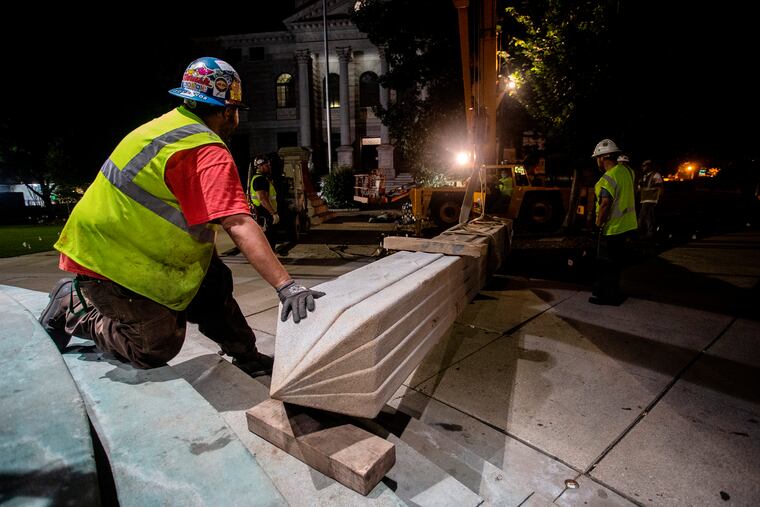Confederate monuments are falling, but hundreds still stand. Here’s where.
Georgia and Virginia have the most remaining monuments, and they have attracted activists like magnets in recent weeks.

Communities had focused anew on long-controversial symbols of the Confederacy after Charleston and the deadly white-nationalist rally in Charlottesville in 2017. Floyd's death on Memorial Day supercharged demands to remove all sorts of stone-and-metal symbols of racial injustice. Some were yanked down by protesters; others were taken down by local authorities.
"I can't say this is a unique situation," Karen Cox, a historian at the University of North Carolina at Charlotte, told The Washington Post earlier this month. "There's a long history since the civil rights movement of actions against the monuments, especially after the Charleston massacre and after Charlottesville. This is the same exact debate we've seen since the end of the Civil War."
While dozens of Confederate monuments have been removed since 2009, as of 2019, more than 775 remained, along with hundreds of names on roads, schools, parks and the like.
Georgia and Virginia have the most remaining monuments — more than 100 each, according to the SPLC — and they have attracted activists like magnets in recent weeks.
Protesters in Richmond, the former capital of the Confederacy, tore down a statue of Confederate President Jefferson Davis and another of Gen. Williams Carter Wickham, and they attempted to topple the 60-foot-high likeness of Gen. Robert E. Lee on Monument Avenue before Virginia Gov. Ralph Northam (D) tweeted on June 4 that it would be taken down. (It is on state property.)
However, lawsuits have been filed and a court injunction has temporarily halted the governor's plan. Richmond City Council leaders, meanwhile, have said they will take down the other Confederate statues along the street, which stand on city land.
Just up I-95 in Alexandria, Va., "Appomattox," which had stood at an Old Town intersection since 1889, was removed a month earlier than planned by the United Daughters of the Confederacy, owners of the long-controversial memorial. Monuments were dismantled in Norfolk, Portsmouth and other Virginia cities as well in the past few weeks.
In Decatur, Ga., a judge ordered that the 30-foot "Lost Cause" obelisk be removed from a town square and placed in storage by June 26. Groups in DeKalb County had spent years trying to get the monument removed and had added a marker near it saying it has "bolstered white supremacy and faulty history," according to the Atlanta Journal-Constitution.
Noted monuments came down in several parts of Alabama, home to at least 60 of them. At the state's flagship university in Tuscaloosa, where Gov. George Wallace stood in a doorway in 1963 to block two African American students from entering, a monument and three plaques that honored students who served in the Confederate army and student cadet corps were removed this month.
An hour away in Birmingham, crews dispatched by the mayor dismantled a 50-foot obelisk memorializing Confederate soldiers and sailors in a downtown park. In Montgomery, protesters pulled down another Lee statue from in front of a high school named for him, and the port city of Mobile was fined for taking down a statue of Adm. Raphael Semmes.
Jacksonville, Fla., which has three Confederate monuments and eight historical markers, will be losing them all, according to its mayor. One, a controversial 62-foot statue and plaque that had stood in a park since 1898, was removed June 9.
In Indianapolis, a monument honoring 1,616 prisoners of war who died at a Union prison camp was removed from a park, where it had been placed by city officials in 1928 at the behest of the Ku Klux Klan.
This list goes on, from Bentonville, Ark., to Louisville to Rocky Mount, N.C., to Fort Worth.
Discussions and legal wrangling over some of these memorials began years — and sometimes decades — ago but have accelerated in recent years, spurred on by new public scrutiny.
Laws in some states make removing Confederate symbols extremely difficult, including in South Carolina, where a law written in 2000 requires two-thirds of legislators have to approve any removal. An Alabama law restricting Confederate removals was enacted in 2017, and it is unclear whether or how the recent removals square with it.
Most Confederate statues and memorials were erected in Southern states, but some also appear in unexpected places such as Arizona and California.
A few were built in the years after the Civil War, but most were produced decades later in the early 20th century when states and municipalities were writing Jim Crow laws codifying racial segregation.
There are 70 monuments not represented here whose dedication date is unknown.
At least 35 monuments have been dedicated since 2000, and at least three went up as recently as 2014 and 2015.
The most recent listed in SPLC data was dedicated in Pearisburg, Va., less than a month after the Charleston shooting. It is a display in the Giles County Courthouse of a medal awarded in 1995 to a soldier who was killed in the 1862 Battle of Williamsburg. He reportedly died clutching the Confederate flag.